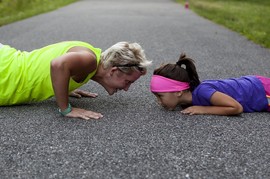By 2050, the global population of individuals over the age of 65 will increase by 188%. As a consequence of the aging population, there has been a noticeable increase in the prevalence of “diseases of aging”, including sarcopenia. Sarcopenia has recently been described as a “syndrome characterized by progressive and generalized loss of skeletal muscle mass and strength with the risk of adverse outcomes such as physical disability, poor quality of life, and death”.

The loss of muscle mass and strength that occurs with aging is predictable and leads to increased frailty. Age-related loss of muscle mass and strength predisposes older adults to falls and can contribute to other functional limitations and have a negative impact on independence.
In an effort to improve the quality of life of the aging population, it is vital for older adults to increase muscle strength to allow them to carry out activities of daily living independently and reduce the risk of falls.
Many risk factors for falls have been identified, including leg weakness, previous falls, problems with balance and walking, visual impairment, cognitive and functional impairment, depression, dizziness, lower body mass index, low blood pressure when standing up, urinary incontinence, polypharmacy (taking over 4 medications), use of psychotropic medication, and being over the age of 80. Exercise has been shown to reduce the risk of falls!
Two key components of a physical activity program for older adults are balance training to maximize stability and minimize falls, and strength training to increase muscle mass. It is important to note that exercise needs to be performed in sufficient amounts and be performed on an ongoing basis to have sustained positive effects. It has been shown that the most effective exercise program for fall prevention and improved muscle mass involves balance training and strength training for more than two hours per week for a minimum of a six month period. A physical therapist at Iron City Physical Therapy can help you figure out what that means for you in particular, and how to incorporate it into a program you love and can continue with.
In addition to improving strength and reducing the risk of falls, exercise is an essential part of healthy aging. In the aging population, exercise also helps to improve cardiovascular health and has also been associated with improved cognitive functioning.
If you’re noticing that your muscles are wasting and you’re not as strong as you once were, you may benefit from physical therapy. Undergoing a comprehensive evaluation by physical therapists at Iron City Physical Therapy is one of the best ways to gain an understanding of how you can enhance your physical state. After the assessment, our physical therapists will create a program that is specific to your needs, and can help to maintain muscle mass and strength as you age.
References
1. McLeod M, Breen L, Hamilton D, Philp A. Live strong and prosper: the importance of skeletal muscle strength for healthy ageing. Biogerontology. 2016;17(3):497-510. doi:10.1007/s10522-015-9631-7.
2. Goldspink G. Age-Related Loss of Muscle Mass and Strength. Journal of Aging Research. 2012;2012:1-11. doi:10.1155/2012/158279.
3. Chen L, Nelson D, Zhao Y, Cui Z, Johnston J. Relationship between muscle mass and muscle strength, and the impact of comorbidities: a population-based, cross-sectional study of older adults in the United States. BMC Geriatr. 2013;13(1). doi:10.1186/1471-2318-13-74.
4. Wan M, Wong RY. Benefits of exercise in the elderly. GCS Journal of CME. 2014;4(1). 5-8.




